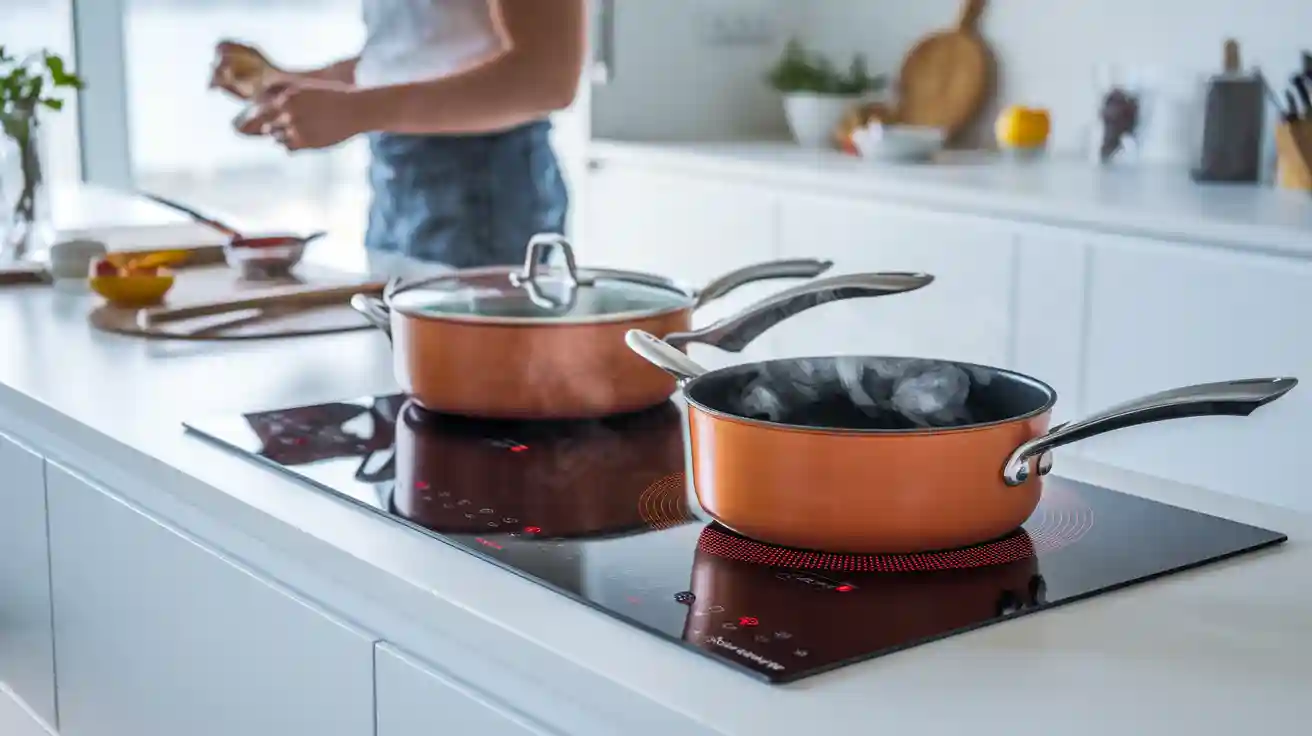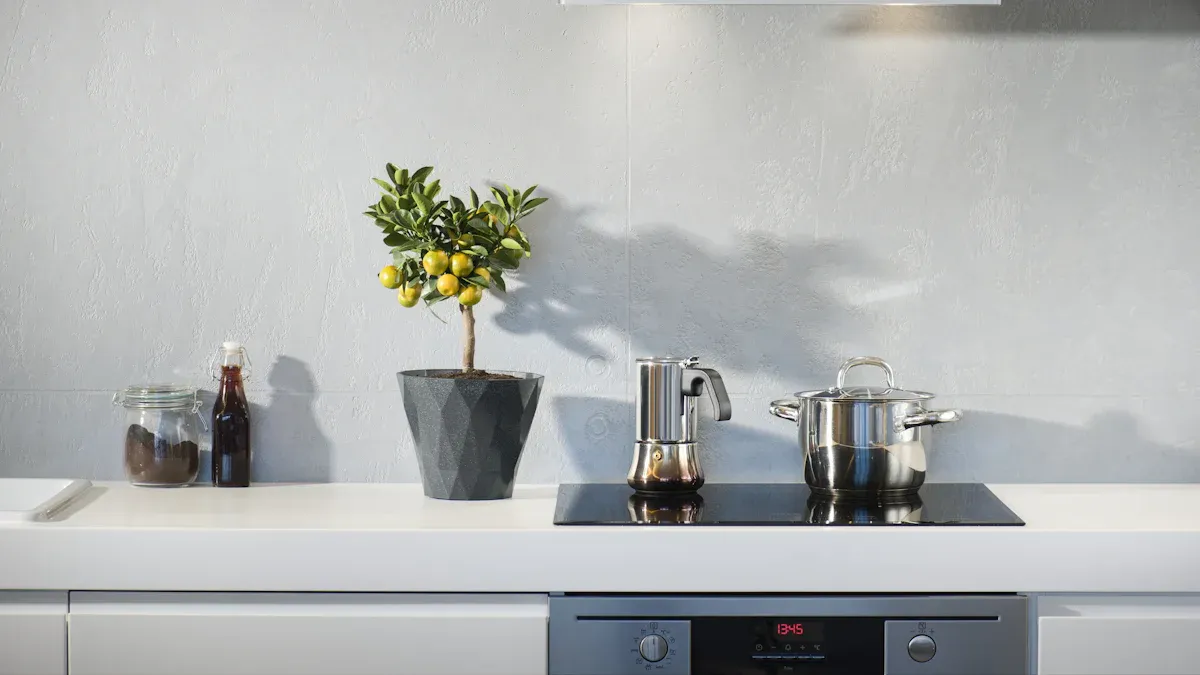
When you choose an induction cookware set, you help your kitchen work smarter. Induction cookware uses magnetic fields to heat your pots and pans directly. This method cuts down on wasted energy and gives you faster, more even cooking. With the right cookware set, you boost energy efficiency and lower your utility bills.
How Induction Works and Why Compatibility Matters
Induction Technology Explained
Induction cooktops use a special technology that heats your cookware directly. When you turn on an induction cooktop, it sends an alternating electric current through a coil under the glass surface. This current creates a magnetic field. When you place induction-compatible cookware on the cooktop, the magnetic field passes into the cookware and causes tiny electric currents, called eddy currents, to flow inside the metal. These currents make the cookware heat up quickly through a process called Joule heating.
You get fast and efficient cooking because the energy goes straight into the cookware, not into the air. Most modern induction cooktops reach about 85-90% efficiency, and some advanced models can even reach 93%. The cooktop surface stays cool, so you waste less heat and can control the temperature instantly. This makes induction cooking safer and more energy-efficient than gas or electric stoves.
Tip: Induction technology helps you save energy and cook faster by heating only the pan, not the whole kitchen.
Induction Cookware Compatibility
You need the right cookware for induction cooking to work. Only induction-compatible cookware will heat up on an induction cooktop. This means your pots and pans must have a magnetic base. You can check this by seeing if a magnet sticks to the bottom. Common induction-compatible materials include cast iron, magnetic stainless steel, and some types of clad aluminum.
- Induction cooktops heat cookware using electromagnetic energy, so the cookware must have a magnetic base.
- Induction-compatible cookware heats quickly and evenly, giving you better cooking results.
- Using the right cookware prevents damage to your induction cooktop and ensures you get the best performance.
If you use cookware that is not induction compatible, it will not heat up or will heat unevenly. This can lead to poor cooking results and wasted energy. Choosing induction-compatible cookware helps you cook efficiently, save energy, and enjoy better meals.
What Makes an Induction Cookware Set Compatible
Magnetic Materials in Induction Cookware
You need the right materials for your cookware to work on an induction cooktop. Induction cooking uses magnetic energy to heat your pots and pans. Only certain metals respond to this energy. Stainless steel, cast iron, and some types of steel are the best choices. These metals have strong magnetic properties. Aluminum, copper, and glass do not work unless they have a special magnetic base.
When you shop for induction compatible cookware, always check the label. Look for words like “induction ready” or “induction compatible.” These labels show that the cookware will work with your induction cooktop. Material compatibility is important because it affects how well your cookware heats up and cooks your food.
Note: If your cookware does not have the right magnetic material, your induction cooktop will not heat it.
The Magnet Test for Compatibility
You can use a simple test to check if your cookware is induction compatible. Take a small magnet and place it on the bottom of your pot or pan. If the magnet sticks firmly, your cookware will work with induction. If the magnet falls off or only sticks a little, the cookware is not induction compatible.
- Place a magnet on the bottom of your cookware.
- If it sticks well, you can use it on your induction cooktop.
- If it does not stick, choose another pot or pan.
This test helps you avoid buying the wrong cookware. It also saves you time and money. Always use this test before you cook on an induction stove.
Key Factors Affecting Induction Cookware Set Efficiency
Material and Construction Quality
You get the best results from induction cooking when you choose cookware made with high-quality materials and solid construction. The quality of your induction cookware set affects how well it transfers energy from the cooktop to your food. When you use cookware with strong magnetic properties and a flat, stable base, you maximize energy transfer and minimize waste. This means you save more energy and cook your meals faster.
Studies show that induction cooktops can save 5% to 20% more energy than traditional electric stoves and over 65% compared to gas stoves. However, these savings depend on the quality of your cookware set. High-quality materials like ferromagnetic stainless steel or multi-ply construction with aluminum or copper layers improve efficient heat distribution and retention. A flat and properly sized base ensures stable contact with the induction cooktop, which boosts efficiency and performance.
- High-quality materials, such as ferritic stainless steel or multi-ply designs, improve heat transfer and durability.
- A flat base maximizes energy transfer and prevents heat loss.
- Thicker materials distribute heat more evenly but may slow down temperature changes.
- Custom cookware designed for induction balances thickness, magnetic properties, and construction for consistent performance.
- Cookware that meets safety standards keeps your cooking safe and reliable.
Tip: Always check for a flat, magnetic base and sturdy construction when choosing an induction cookware set. This ensures efficient heat distribution and long-lasting performance.
Heat Distribution and Retention in Induction Cookware
Efficient heat distribution and retention are key to great cooking results. When your cookware spreads heat evenly, you avoid hot spots and get even heating across the entire surface. This helps you cook food thoroughly and prevents burning or undercooking.
| Material | Heat Distribution Characteristics | Heat Retention Characteristics | Induction Compatibility & Notes |
|---|---|---|---|
| Stainless Steel | Moderate conductor; better with aluminum/copper core | Good retention; durable and corrosion-resistant | Magnetic, often layered for better heat |
| Cast Iron | Heats slowly, distributes heat evenly | Excellent retention, keeps temperature steady | Magnetic, ideal for induction |
| Hard-Anodized Aluminum | Excellent conductor and distributor | Moderate retention; durable | Not magnetic alone; often used as core in stainless steel sets |
| Copper | Unmatched conductivity, precise temperature control | Moderate retention; fast heating and cooling | Usually lined with stainless steel for induction compatibility |
| Ceramic | Heats evenly but slower than metals | Moderate retention; non-reactive surface | Not magnetic; may need special induction bases |
When you use cookware with the right thickness, you get better heat retention and cooking performance. If the pot bottom is too thin (less than 1.5 mm), heat generation increases, but you may lose structural strength. If it is too thick, you do not gain much more efficiency. The best induction cookware balances thickness for efficient heat distribution and durability.
Note: Choose cookware that offers even heat distribution and good retention. This helps you cook food evenly and keeps your meals warm longer.
Design Features for Better Induction Performance
The design of your induction cookware set plays a big role in how well it works. Certain features help you get the most out of your induction cooking experience.
- Thick bases prevent hot spots and promote even heating.
- Heavy gauge forged aluminum construction gives fast and efficient heat distribution.
- Stainless steel induction bases ensure compatibility with induction cooktops.
- Non-stick coatings make cleanup easy and keep food from sticking.
- Heat-resistant handles improve safety and comfort while cooking.
- Rapid heating from electromagnetic technology reduces cooking time.
- Durable materials allow you to use your cookware set for many types of cooking.
Some advanced induction cookware includes built-in temperature sensors. These sensors give you precise temperature control, which is important for delicate dishes. Automatic cookware detection only activates heating when the right cookware is present, saving energy and improving safety. Some sets even have indicators that rate cookware compatibility, helping you choose the best option for your cooktop.
Recent advancements use multi-layered materials, such as stainless steel with magnetic bottoms or cast iron with special coatings. These innovations improve heat transfer and ensure your cookware works with all induction cooktops. When you select a set with these features, you get efficient heat distribution, precise temperature control, and consistent performance every time you cook.
Callout: Look for induction cookware sets with features like thick bases, multi-layer construction, and temperature sensors. These features boost efficiency and make your cooking experience easier and safer.
Choosing the Best Induction Cookware Set
Practical Tips for Selecting Induction Cookware
When you start looking for the best cookware for induction, you want to make smart choices. The right induction cookware set will help you cook better, save energy, and enjoy your time in the kitchen. Here are some practical tips to guide you:
-
Check What’s Included
Look at the pieces in each set. Do you need both a 2-quart and a 3-quart saucepan? Make sure the set matches your cooking habits. Some sets leave out important items like a stockpot or a grill pan. You may need to buy these separately. -
Focus on Material and Construction
The best induction cookware uses ferromagnetic materials. Stainless steel with an aluminum or copper core gives you even heat and durability. Cast iron holds heat well and works great for searing. Enameled cast iron is easier to clean and does not need seasoning. Nonstick pans with an induction base are perfect for eggs and pancakes. -
Test for Compatibility
Use a simple magnet test. Place a fridge magnet on the bottom of the cookware. If it sticks firmly, the cookware is induction-compatible. This quick test helps you avoid mistakes. -
Balance Quality and Budget
High-quality cookware costs more, but it lasts longer and performs better. Investing in a good induction cookware set saves you money over time. Avoid buying sets with pieces you will never use. -
Look for Even Heat Distribution
Choose cookware with encapsulated or stainless steel bases. These bases spread heat evenly and prevent hot spots. Even heat helps you cook food perfectly every time.
Tip: Always match your cookware to your cooking style. If you love making sauces, pick a set with several saucepans. If you bake or roast, look for oven-safe options.
Here is a table to help you compare different types of induction-ready cookware:
| Cookware Type | Material/Construction | Key Features and Considerations |
|---|---|---|
| Stainless Steel | Often with aluminum or copper core | Durable, induction-compatible, even heat distribution |
| Cast Iron | Solid cast iron | Excellent heat retention, heavy, induction-compatible |
| Enameled Cast Iron | Cast iron with enamel coating | Easier to clean, no seasoning needed, induction-compatible |
| Induction-Compatible Nonstick | Aluminum core with induction base, PFOA-free coatings | Easy food release, some environmentally friendly options |
When you compare brands, you will see differences in performance. For example, GreenPan Valencia Pro stands out for its even heat, silent operation, and high boiling efficiency. Made In Non-Stick heats up fast but may not spread heat as evenly. Tramontina and Cuisinart offer good cooking results and reliable performance. The best cookware for induction often uses PTFE or ceramic coatings, which affect durability and oven safety.
If you want more induction cooking tips, remember to use soft sponges for cleaning, avoid sudden temperature changes, and store your pans carefully. These habits keep your cookware working well for years.
What to Look for on Induction Cookware Labels
When you shop for an induction cookware set, you need to know what to look for on the labels and packaging. This helps you find the best induction cookware and avoid costly mistakes.
-
Induction Compatibility Symbol
Look for a coil or zig-zag symbol stamped on the bottom of the cookware or printed on the box. This symbol means the cookware is ready for induction cooking. -
Magnet Test
If you cannot find the symbol, use a magnet. If it sticks to the bottom, the cookware is induction-compatible. -
Material Information
Check the label for details about the materials. The ideal induction-ready cookware uses ferromagnetic stainless steel, cast iron, or enameled cast iron. Some stainless steel pans may not work if they have too much nickel. -
Phrases to Watch For
Look for phrases like “suitable for induction” or “works on all stovetops.” These phrases show that the cookware will work on your induction cooktop. -
No Official Certification
There is no official certification for induction compatibility. Always rely on the symbol, the magnet test, and the material listed on the label.
Note: If you see a coiled spring symbol or the words “induction compatible,” you can trust that the cookware will work on your induction stove.
When you follow these steps, you make sure you get the best cookware for induction. You avoid wasting money on pans that do not work. You also enjoy faster, safer, and more efficient cooking every day.
Real-World Benefits of Efficient Induction Cookware

Faster Cooking and Energy Savings
When you use an efficient induction cookware set, you notice how quickly your meals come together. Induction cooking heats your pots and pans directly, so you do not waste time waiting for burners to warm up. In real-world tests, water can go from frozen to boiling in just seconds. You can cook shrimp with perfect color and sauce in about two minutes, which is much faster than with traditional stoves. This speed means you spend less time in the kitchen and more time enjoying your food.
Induction cooktops are up to three times more efficient than gas stoves and about 10% more efficient than electric ranges. You boil water 20-40% faster, which saves both time and energy. Because induction heats only the cookware, your kitchen stays cooler, and your air conditioning works less. Many households see lower energy bills after switching to induction. Some families even qualify for rebates up to $840, making the switch more affordable. When you choose the best cookware for induction, you boost your kitchen’s energy efficiency and save money every month.
Tip: Faster cooking and lower bills make induction cookware a smart choice for busy families.
Safety and Cooking Results with Induction
Induction cooking offers important safety benefits for your home. Unlike gas stoves, induction cooktops do not release harmful chemicals like benzene, which can cause health problems. Studies show that gas stoves are linked to higher rates of childhood asthma. Induction keeps your kitchen air clean and safe.
| Safety Benefit | Explanation |
|---|---|
| No harmful indoor pollutants | Induction does not emit chemicals linked to cancer or asthma, unlike gas stoves. |
| Reduced asthma risk | Gas stoves are linked to 12.7% of childhood asthma cases in the U.S. |
| Cooler kitchen environment | Induction heats only the pan, not the air, so your kitchen stays cooler and safer. |
| Smart safety features | Auto-shutoff, timers, and precise heating help prevent accidents and burns. |
You also get better cooking results with induction cookware. Induction heats up two to three times faster than gas, giving you quick and even results. You control the temperature precisely, so your food cooks just the way you want. When you turn off the burner, the heat stops right away, which helps prevent overcooking. The best induction cookware gives you consistent performance and makes cleanup easy because the cooktop stays cool and food does not burn onto the surface.
Caring for Your Induction Cookware Set
Cleaning and Maintenance for Induction Cookware
You keep your induction cookware working well by cleaning it the right way. After each use, let your cookware and cooktop cool down before you start cleaning. This helps prevent warping and protects the surface. Follow these steps for best results:
- Use a soft cloth or non-abrasive sponge with warm water and mild dish soap to wipe away food and grease.
- For stubborn spots, spray a little diluted vinegar or a gentle cooktop cleaner and let it sit for 10 to 15 minutes.
- Gently scrape off any burnt-on residue with a flat scraper held flat against the surface.
- Wipe again with a soft cloth until the surface is clean.
- Dry your cookware right away to prevent water spots or rust.
Tip: Avoid steel wool, harsh abrasives, and ammonia-based cleaners. These can scratch or damage your induction cookware and cooktop.
If you use nonstick induction pans, always handwash them and avoid the dishwasher. Let pans cool before washing to keep them from warping.
Preserving Efficiency Over Time
You can make your induction cookware last longer and work better with a few simple habits. Always use wooden, silicone, or plastic utensils to protect the cooking surface. Avoid stacking heavy or sharp-edged pans, or place a soft cloth between them to prevent scratches.
- Dry cookware completely after washing to stop rust and water spots.
- Season cast iron pans by rubbing on a thin layer of oil and heating them. This keeps the surface nonstick and rust-free.
- Use medium or low heat settings. High heat can damage coatings and cause warping.
- Never heat an empty pan. This can ruin the nonstick surface or warp the base.
- Check your cookware for scratches, warping, or peeling. Replace damaged pieces to keep your induction cooking safe and efficient.
Note: Following the manufacturer’s care instructions helps you avoid common mistakes that reduce efficiency, like using the wrong heat setting or skipping regular cleaning.
By caring for your induction cookware set, you keep your kitchen running smoothly and enjoy great cooking results for years.
Efficient induction cookware sets help you save energy and cook better meals.
- Flat, magnetic cookware heats quickly and reduces waste
- Precise controls improve results and lower bills
- Regular cleaning keeps your set working well
- Smart features and good habits can cut kitchen energy use by up to 35%
Choose the right set to enjoy faster, safer, and more efficient cooking.
FAQ
What happens if you use non-induction cookware on an induction cooktop?
Your cooktop will not heat the pan. The pan stays cold. Only cookware with a magnetic base works with induction technology.
How do you know if your cookware is induction compatible?
Place a magnet on the bottom of your pan. If it sticks firmly, your cookware is induction compatible. If it does not stick, you need a different pan.
Can you use metal utensils with induction cookware?
Use wooden or silicone utensils. Metal utensils can scratch nonstick coatings and damage your cookware. Protect your pans to keep them working well.


